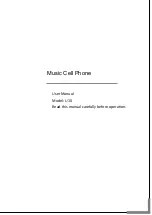
(((ELKRON))) - CT10-M / CT11-M
14
2. GSM network temporarily down with consequent impossibility to make calls:
The commutator starts the procedure by calling the first telephone number. The call is
immediately interrupted and marked as “failed” since there is no GSM network recep-
tion. The communicator will make another attempt to call the same number if this is
the only programmed number. Otherwise, the communicator will go to the next
number and so forth. Three attempts will be made to call each telephone number
supposing that GSM network reception is restored. At this point, the call cycle will be
marked as “done”. If GSM coverage is not restored in time, the telephone failure
output will be switched (see paragraph 5.3 “Description of outputs”). The “Telephone
failure memory” LED on the panel will blink for time-out or stay on fixed if the cycle
was not completed. CT11-M will repeat failed calls on the PSTN line, if enabled (auto-
matic back-up function, see paragraph 6.4).
3. GSM call to unavailable number (cellular telephone off, busy, no answer or
answering service on):
The communicator cannot detect these conditions for which the call will be consid-
ered “done” and the cycle will continue normally.
6.3 PSTN VOICE CALL CYCLE (CT11-M only)
• A voice call is made to each telephone number associated to a programmed PSTN
channel following an alarm. A basic message (10 sec.) is followed by the specific mes-
sage related to the event: input, output or failure. Other specific messages will be added
if other events to which the telephone number which is receiving the call is associated
occurs at the same time.
• The voice message will be repeated three times to each telephone number. After this,
the call will be ended and the other programmed numbers will be called. A tone allowing
the user who is listening to the message to enter the “Barring code” (
12
in DTMF, see
paragraph 6.4 “STOPPING THE CALL CYCLE”) will be sent at the end of each voice
message. If the call cycle is not locked, the cycle will continue with the next number. The
programmed telephone numbers are called in sequence from the first to the last, for a
total of three cycles.
• In the case of tones and active answer check, call outcome will depend on line tone
detection (see “Installation menu”, paragraph 8.10).
The tone and reply test while a call is being made on the PSTN line may be
affected by the possible periodical connection of the GSM module.
6.4 VOICE CALL BACKUP (CT11-M only)
• A back-up function has been implemented to additionally reduce the risk that an event is
not reported because of problems concerning one of the two telephone networks (GSM
or PSTN). The main reasons for automatically activating back-up can be:
- temporary lack of GSM network coverage
- no answer from PSTN call user following a call from a GSM call user
- no PSTN network (if tone check is enabled).
In these cases, the programmed voice call sent to a certain telephone network will be
automatically sent to the alternative network.















































